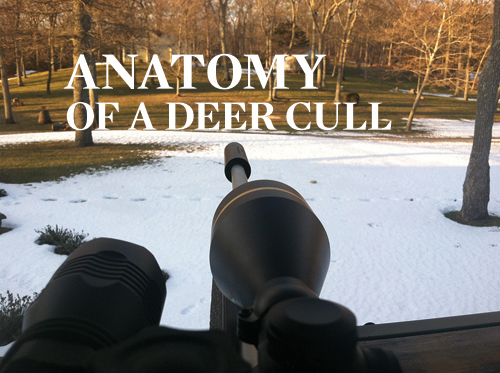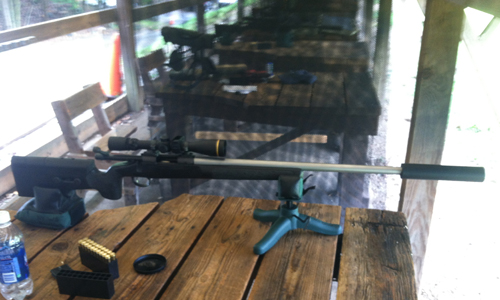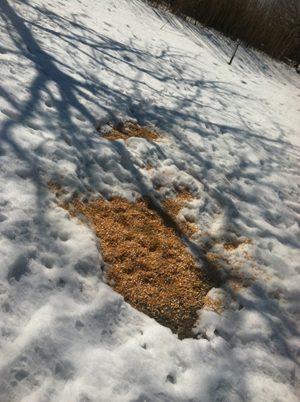Ex-federal sharpshooter takes us inside the hunt

My stomach growled with the uneasy nausea that troubles me whenever I work overnight several days in a row. I grabbed a handful of the sugary snacks I always keep on hand to squelch the rumblings and ensure my eyelids stay wide open during these 16-hour stints.
As I glanced down at my watch, I heard a twig snap in the distance. I slowly swung my rifle in the direction of the noise and brought my cheek to rest on the firearm’s comb.
The combination of the full moon and freshly fallen snow had provided enough light for me to slowly scan the horizon through the rifle’s scope, carefully looking for movement. As I found the noise’s source, I steadied the reticle and slowly exhaled as I silently released the safety. At the bottom of my breath, I squeezed the trigger all the way through the hollow report of the suppressor. After a moment, I traded the rifle for the spotlight.
 Flicking the switch, the red spider web in the snow behind the yearling doe confirmed my shot had rung true. The gravity of the situation was not lost on me, even though it was the seventh time I had pulled the trigger that evening. I had taken another life; and it probably wouldn’t be the last before the first rays of the sun begin to filter in.
Flicking the switch, the red spider web in the snow behind the yearling doe confirmed my shot had rung true. The gravity of the situation was not lost on me, even though it was the seventh time I had pulled the trigger that evening. I had taken another life; and it probably wouldn’t be the last before the first rays of the sun begin to filter in.
Such is another night of culling deer for the U.S. Department of Agriculture.
Many in the wildlife world are aware of these control operations, but most in the public have no idea they are occurring. Hundreds of these initiatives occur across the country every year, for various reasons. When an operation pops up, it tends to raise a bit of attention in the local area, from both the citizens and animal rights’ groups and, ultimately, the local media. The outrage lasts for a while and the agency conducting the work fires up its PR machine and conducts outreach in an effort to educate the residents. But for most, these operations remain shrouded in mystery, as the general public on a national level has not yet accepted them, and they are predominantly conducted in the shadows.
As civilization keeps encroaching on the last few remaining wild places, conflict between humans and wildlife continues to increase. It can be said that wildlife is not the problem; it’s the humans.

The problem doesn’t lie with colonial nesting seabirds; the issue arises when a runway springs up next to their rookery. The Canada goose of years past posed little concern; it’s the large concentrations of non-migratory residents created by well-meaning people that dump hundreds of pounds of corn at a municipal park that are wreaking havoc. Deer pose little danger in the big woods of Maine; on the LIE they pose a threat to human life and property.
[Mr. Albanese answered reader questions regarding his experiences in deer culls on suffolktimes.com Friday afternoon. Click here to read the recap.]
There is a concept in wildlife management called charismatic mega fauna. This term is used to describe large animal species with widespread appeal. These are the “cute” species, which therefore garner a lot of public support. New York City has been waging war on the Norway rat for over a century; the placards denoting the use of Rozol, a pesticide used for lethal control, are present in nearly every subway terminal. However we don’t often hear of outrage when it comes to the mass killing of NYC’s rodent populations. Why? You may ask. The answer is simple: Humans have historically considered rodents vermin and therefore not entitled to the protections we would give “more desirable” species, such as the white-tailed deer.
White-tailed deer, like many wildlife populations, have experienced a major upswing in recent years. These deer occupy a unique niche. They are considered a keystone species — that is, an animal capable of altering its environment. If you have ever been to Long Island’s Pine Barrens Region, you can see this for yourself, as they have removed almost the entire understory plant community through their browsing. However, there are certain environmental conditions they can’t alter and must therefore adapt to.
Development has occurred over much of their historic range and, while they can mow down bushes and grasses, they stand little chance against brick and mortar. But they have proven capable of acclimatizing to suburbia quite well. The lush landscaping of the ideal American home provides ample nourishment, often year round, with many evergreens being used in ornamental horticulture. And the same cozy retreat that the backyard offers to the homes’ occupants it also provides for white-tailed deer, keeping them safe from hunters’ arrows and other would-be perils.
Most culls begin months before the first shot ever rings out. Local populations are very carefully studied to determine density. Surveys are conducted in an effort to quantify the damage done to the surrounding countryside. Interviews with residents are conducted to determine areas of activity and damage and the corresponding time period. Permission is obtained from these landowners to begin proceedings on their properties. Once heavy-use areas are established, the camera traps come out. These motion-triggered cameras serve as 24-hour sentinels and are strategically placed to verify people’s statements about the travel corridors and times.

After the highest traffic areas have been identified, the baiting begins. The purpose of the bait isn’t so much to concentrate the deer herd as it is to provide the sharpshooters with safe, ethical shots on their quarry. While safety is paramount, animal welfare is a major concern. Because these operations are literally conducted in people’s backyards, having as much control of all the variables as possible is extremely imperative. Every precaution is taken to ensure quick, clean kills. Often, the shooters will be positioned on someone’s deck or porch or in a children’s tree house. Because of this, safe shooting lanes are often very narrow and the operators use whatever terrain features are available as a backstop for their shot.
There is a saying: Once the trigger is pulled, the work begins. This is certainly true when it comes to deer removals. Most nights, the sharpshooters get in their stands around 2 p.m. and stay until 4 or 5 the next morning, depending on how productive the night has been. That’s when the manual labor begins.
All of the animals harvested must be dragged to the vehicles and loaded in. Typically, all the animals are taken to a central location, where the arduous work of field dressing begins. All of the animals’ internal organs are removed and the chest cavities are propped open to allow for proper cooling. Depending on the individual effort, the deer are left to be picked up by town officials or taken to a taxidermist or butcher for further processing. Because it would be considered a conflict of interest if government employees kept any, all meat is donated to various programs for the underprivileged.
It is easy to vilify these actions. As humans, we fear what we don’t understand. As a society we have been so far removed from the circle of life by the conveniences of the modern world. The vast majority of the population lives in cities, tucked out of view of the farms that provide us with our sustenance. For most people, meat is a commodity purchased at a store, neatly packaged in Styrofoam and plastic wrap. A hamburger isn’t a calf reared to adulthood solely for its delicate flesh; it’s an entity cooked up in the back at your favorite restaurant. Eggs aren’t the failed offspring of chickens; they are a favorite ingredient in a breakfast sandwich served at your cart of choice.
One of the great truths of the universe is lost in translation: Not only does death happen on a regular basis, it needs to continue to happen for life to go on.
It is easy to condemn these control measures as barbaric and cruel. But absent natural predators, deer populations grow unchecked, ultimately culminating in a catastrophic event of some sort. When populations get that large, disease can run rampant. Because the individual animals ranges overlap so much, viruses are transmitted very quickly. And with so many animals straining the ecosystem, any blight is magnified. The effects of a harsh winter are amplified, as many animals have to compete for already diminished resources. A species can exceed the carrying capacity of its environment only for so long.
As a race, human beings have carved an indelible mark across the face of the globe. Man is the ultimate keystone species; we have so altered the world we live in, for better and for worse. Our most basic need for shelter has taken large swathes of the greenscape and replaced it with dwellings. And we will continue to do so, as our race continues to reproduce and our populace grows.
This leaves us with a dilemma as a people: Where do we stop altering our environment? With all the drastic changes we have made so far, can we just stop now? To do so would be irresponsible.
Short of demolishing homes and returning that land to a wild state, our only option is to take responsibility for our previous actions. Our lifestyles created the perfect storm that allowed deer populations to reach these astronomical levels.
It would be irresponsible to not practice the best stewardship supported by science by reducing their numbers to more accurately reflect the carrying capacity, so these noble creatures aren’t handed a death sentence to be carried out by starvation, or a Saab bumper.
I lie somewhere in the midst of these tough decisions. This is the world we live in, the way of life I, along with the rest of society, chose. I am as responsible as everyone else. I have helped create this situation that I now find myself in: between a rock and a hard place
I make the best decision science will let me.
 Joseph Albanese is a wildlife biologist with a decade of experience in natural resources. He has worked for both the U.S. Fish & Wildlife Service and the U.S. Department of Agriculture, among over government agencies. He lives in Nassau County.
Joseph Albanese is a wildlife biologist with a decade of experience in natural resources. He has worked for both the U.S. Fish & Wildlife Service and the U.S. Department of Agriculture, among over government agencies. He lives in Nassau County.






